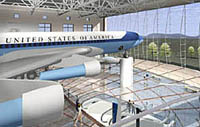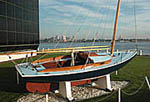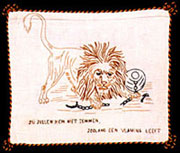
Found at the Presidential Libraries
Dr. Seuss, Air Force One, and the San Diego Chicken
Winter 2003, Vol. 35, No. 4
By Ellen Fried
Ten presidential libraries, administered by the National Archives and Records Administration (NARA), serve as rich repositories for the records of our nation's highest office. Together, these libraries house more than 400 million pages of letters, diaries, speeches, memos, and other documents, as well as photographs, film, and audiotape.
But the libraries also keep artifacts of all sizes and descriptions. These items provide tangible evidence of the lives, times, and achievements of the country's chief executives. Some of the artifacts are impressive, some are unique, and some come with poignant or amusing stories. And some of them might surprise you.
Planes, Cars, and Boats
For sheer size and grandeur, it's hard to beat Air Force One. A retired specimen of the President's airborne headquarters arrived at the Reagan Library this past summer.
The Boeing 707 was retired in September 2001, after twenty-eight years of service. It had carried seven U.S. Presidents—every one since Richard Nixon. President Ronald Reagan used this plane exclusively during his eight years in office and logged more miles on it than any of the other six Presidents.
After the plane was retired, it was flown to San Bernardino International Airport, where it was disassembled and stored. Then it made the trip to the Reagan Library in pieces, with one truck towing the enormous fuselage and two others carrying the wings. Visitors will be able to walk through the reassembled Air Force One when it goes on display in a new museum wing, which is scheduled to open in late 2004.
The Reagan Library is the only one with a genuine Air Force One, but plenty of other vehicles can be found at other presidential libraries.
Early in his life, Harry S. Truman recognized the power of mobility. As a young man courting Bess Wallace, he had to take a train to get from his grandmother's farm in Grandview, Missouri, to Independence, where Bess lived. In 1913 he bought his first car—a model Stafford touring car that made the journey much more comfortable and convenient.
His first car may have been a Stafford, but the next was a Chrysler—and from then on, he was loyal to Chryslers.
In November 1940, while Truman was a senator from Missouri, he and his wife purchased two 1941 Chryslers—a coupe and a sedan. After the Trumans moved to the White House in 1945, the cars passed through a series of other owners. By the time they reached the Truman Library, they were in pretty rough shape.
In the mid-1990s, a team from the Chrysler Corporation began meticulously restoring the cars, using records in their own archives to ensure historical accuracy. The Truman Chryslers are now back on display at the Truman Library, looking much as they did when Harry and Bess Truman purchased them more than sixty years ago.
Wheelchair-bound Franklin Delano Roosevelt had his own reason to appreciate the freedom a car could provide. In 1936 he purchased a blue V-8 Ford DeLuxe Phaeton convertible and had it equipped with hand controls for the clutch, brake, and throttle. He used the car at his home in Hyde Park, New York, and with it was able to move freely around his estate and the surrounding countryside.
"He loved that car," said NARA's Richard Claypoole, assistant archivist for presidential libraries. "It was the only thing that gave him mobility."
After President Roosevelt's death, Eleanor Roosevelt donated the car to the Roosevelt Library, where it is now on permanent display.
John F. Kennedy's passion for the sea was legendary, and perhaps no single item better represented that passion than his beloved sailboat, Victura. Dave Powers, a longtime friend of President Kennedy and founding curator of the Kennedy Library, wrote:
Victura was among the President's most prized possessions. A gift on his fifteenth birthday, he sailed it as a young man, Navy hero, Congressman, Senator, and finally as President. It was on the Victura that he began winning races at the age of 15, and on which he taught his wife Jacqueline how to sail. If the President wasn't sailing on Victura, he was thinking about it as evidenced by his many doodles of the sailboat. . . . When the President visited Hyannis Port, he was never happier than when he was at the helm of Victura.
Victura now stands on the lawn of the Kennedy Library, with its bow pointed toward the entrance to Boston Harbor.
Hello, Sports Fans
Many Presidents have been athletes and sports fans—and one President portrayed an athlete in a movie. That's how NARA ended up with some remarkable sports memorabilia in its collection.
Before any other costumed mascot graced a professional playing field, there was the San Diego Chicken. It all started in 1974, when a San Diego State University student named Ted Giannoulas took a weeklong job performing in a rented chicken suit as a promotional stunt for a local radio station. When the gig was up, Giannoulas offered to stay on and attend San Diego Padres games in character. The radio station would get more publicity, and Giannoulas would get to see baseball games for free.
His stadium antics were a huge hit. Before long, the San Diego Chicken had become a celebrity in its home city and was attracting national attention. Other costumed characters started showing up at pro games around the country, but the San Diego Chicken was the first. In 1976 President Gerald R. Ford, himself a former college athlete, met the famous chicken during a visit to San Diego. The encounter sparked an idea in the mind of Jim Naughton, a White House correspondent for the New York Times—and a notorious prankster. Naughton contacted Giannoulas and purchased the head from a San Diego Chicken costume. At a late-night press conference in Portland, as President Ford answered questions from reporters, Naughton suddenly appeared, wearing the big yellow chicken head. The unflustered President didn't miss a beat; he went right on answering questions.
Naughton later donated the chicken head to the Ford Library. The head is not currently on display, but the library plans to exhibit it soon at the Ford Museum, in Grand Rapids, Michigan.
In 1940, young actor Ronald Reagan got his big break—playing the role of Notre Dame football legend George Gipp in the film Knute Rockne—All American. He almost didn't get the part; the producer didn't think he looked like a football player. The producer changed his mind when he saw a photo of Reagan in his college football gear.
In the movie, the dying Gipp tells his coach, "Some day, when things are tough, maybe you can ask the boys to go in there and win just one for the Gipper." The line "win one for the Gipper" would become one of President's Reagan's trademarks.
In 1989, just two days before he left office, President Reagan received a visit from sixty Notre Dame players, their coach, and the university president. They presented the President with a priceless university relic: the monogrammed letter sweater that the real George Gipp wore during his 1917–1920 tenure with the Fighting Irish. "That's a great sacrifice by the university," said Reagan. "No one will treasure it more than I will."
The sweater now hangs in the Reagan Library, where other sports fans can admire it as well.
A Door and a House
Presidents receive lots of gifts from foreign heads of state, and many of these gifts end up in the presidential libraries. Some gifts have special meaning, reflecting powerful ties that bind two countries together. Such is the case with one item in the collection of the Bush Library.
According to Kuwaiti custom, when a man gives you the key to his home, he is your friend for life. When a man gives you the door to his home, you are a member of his family forever.
In 1993 the Emir of Kuwait presented President George H. W. Bush with a nineteenth-century Kuwaiti door made of teak with dome-studded nails. Around the door are gold plates listing the U.S. casualties of Desert Shield and Desert Storm. The door is now on display at the Bush Library, as part of an exhibit that documents the events of the Gulf War.
While the Bush Library has a door, the Eisenhower Library has an entire house. It's the only presidential historic structure owned and operated by NARA.
The Eisenhower family home was built in 1887 in Abilene, Kansas. David and Ida Eisenhower bought the house in 1898, when their son Dwight was eight. The future President lived in the house until he went off to West Point in 1911; the family continued to occupy it until Ida Eisenhower's death in 1946. Then the sons donated the house to the Eisenhower Foundation, which maintained it until it was given to NARA.
When the time came to build a presidential library and museum, these structures were built on either side of the family home. "Everyone thinks we moved the house in," said museum curator Dennis Medina. "Actually, we built around it." With the exception of one rug—which is a replica—all of the contents are original. Visitors may tour the house free of charge.
Art of a Different Sort
The presidential libraries have plenty of art, including numerous portraits of Presidents. But the Johnson Museum has artwork you might not expect—a set of original drawings by Dr. Seuss, America's best-loved author of children's books.
It's the artwork from The Lorax, which Dr. Seuss considered his finest work. The book, written in Dr. Seuss's trademark whimsical rhyme, tells the tale of a creature who "speaks for the trees." The Lorax wages a courageous battle against an evil creature called the Once-ler, who cuts down trees to make thneeds, "which everyone needs."
In a 1986 exhibition catalog, Dr. Seuss—whose real name was Theodor Seuss Geisel—described in his own words how the artwork from The Lorax came to be in the Johnson Library:
I don't have The Lorax here [at home]. It's in Texas, and you may wonder why. I was at a dinner for Democrats some years ago, and I sat next to Liz Carpenter, who was [Lady Bird's] press secretary. Since Lady Bird was so interested in beautification, it seemed that environmental protection was a safe topic, so I mentioned that I had written a book on the subject. Liz seemed interested, but soon after, she left the room. When she reappeared, she called me to the phone and said, "The President wants to talk to you." I said "Hello" and there was LBJ thanking me for donating the drawings of The Lorax to his library in Austin, Texas.
The gift consisted of two sets of art—preliminary crayon drawings and final pen-and-ink line art. The artwork was displayed last year in an exhibition called "LBJ on Display: Highlights of the Museum's Collection."
Momentous Events
Some items have a special impact because of their ties to major events or achievements that took place during a President's time in office.
On July 20, 1969, during the administration of President Richard Nixon, humans walked on the Moon for the first time—a momentous event that commanded the attention of the world. Via satellite link, Nixon called Apollo 11 astronauts Neil Armstrong and Buzz Aldrin to congratulate them.
"Neil and Buzz," Nixon said, "I am talking to you by telephone from the Oval Room at the White House. And this certainly has to be the most historic telephone call ever made."
The telephone from which Nixon made that historic call is part of NARA's Nixon Presidential Materials collection. Under the provisions of a 1974 law, materials related to the Nixon Presidency are handled differently from those of other Presidents. NARA does not operate a library for Nixon, but some of NARA's materials—including the telephone from which Nixon talked to the moon—are on loan to the privately owned Richard Nixon Library* and Birthplace in Yorba Linda, California, where they can be seen on display.
One of Jimmy Carter's most memorable achievements was mediating a set of difficult negotiations between the leaders of Israel and Egypt—two countries that had been at war for decades. The meetings ended with the signing of "A Framework for Peace in the Middle East Agreed at Camp David," better known as the Camp David Accords. The agreements made in those accords have been honored to this day.
In 2002 the Norwegian Nobel Committee awarded that year's Nobel Peace Prize to Jimmy Carter, in part for his role in the Camp David Accords. Just eleven days after receiving the award, Carter transferred it to the Carter Library, where it is now on display.
[*The Nixon Library became part of the National Archives and Records Administration in 2007.]
Coconut Shells and Flour Sacks
What's so remarkable about a coconut shell or a bunch of old flour sacks? Nothing - until you hear the story behind them.
During World War II, John F. Kennedy commanded a patrol-torpedo boat—PT-109—in the South Pacific. One night in 1943, the boat was cut in half by a Japanese destroyer. Two of the crew were lost; Kennedy helped the eleven survivors reach a small island. Then he did his best to rescue his men, swimming from island to island at night in the hope of finding help.
On the fourth night, on an island called Naru, he finally encountered some islanders. Using a jackknife, he scratched a message on a coconut shell: "NAURO ISL COMMANDER . . . NATIVE KNOWS POS'IT . . . HE CAN PILOT . . . 11 ALIVE NEED SMALL BOAT . . . KENNEDY." Then he gave the shell to the islanders and said "Rendova" - the name of the island where the PT base was located. The islanders took the shell and paddled off in a canoe.
A day later, Kennedy and his men were rescued. Years later, Kennedy had a piece of the coconut shell mounted as a memento. He kept it on his desk, first in the Senate and then in the Oval Office. It is now on display at the Kennedy Library.
Exhibit specialist Jim Wagner recalls former curator Powers pointing out that the coconut shell was the most important item in the library's collection. Wagner explains, "If not for the coconut shell, JFK may not have been rescued—and he never would have been elected President."
In August 1914, the German army invaded Belgium; by fall, the tiny kingdom—dependent on imports for most of its food—faced mass starvation. Herbert Hoover, a prosperous mining engineer, was asked to undertake an unprecedented relief effort. After some soul-searching, he agreed to assume the administration of what became known as the Commission for the Relief of Belgium (CRB). The CRB shipped seven hundred million pounds of flour to Belgium, saving ten million lives.
The flour was packed in cotton sacks by American and Canadian mills. Cotton was in great demand by the Germans, who used it to clean gun barrels, so the movement of the flour sacks through Belgium was carefully controlled by the CRB. The empty flour sacks were distributed to sewing schools and workshops, where some of them were turned into clothing, pillows, and other functional items. But many women chose to embroider the sacks with elaborate expressions of thanks to the Americans.
Several hundred of these decorated flour sacks were presented as gifts to Hoover. About four hundred of them are now in the collection of the Hoover Library—a moving tribute to Hoover's compassion and the extraordinary humanitarian effort he undertook.
"What I particularly value about the artifacts in the presidential libraries," says Claypoole, "is that they are not always what you'd expect. Their display is not the primary purpose of the libraries, but their presence in the libraries provides an immediate and often powerful connection to our Presidents and our history. These objects serve to remind thousands of library visitors each year that our Presidents were mortal human beings whose interests, values, and experiences, while extraordinary at times, at other times simply reflected those of the men and women they were privileged to serve."
Ellen Fried is on the Policy and Communications Staff at the National Archives and Records Administration.




